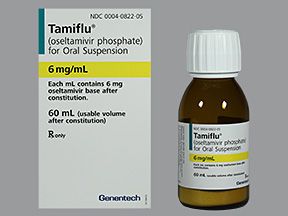Tamiflu (oseltamivir) is a brand-name drug that’s prescribed for the flu. Tamiflu comes as a capsule and liquid suspension, both of which you take by mouth. The dosage varies depending on whether the drug is used to treat or help prevent the flu.
Tamiflu belongs to a drug class called antivirals. Tamiflu is available in a generic version.
Keep reading for specific information about the dosage of Tamiflu, including its strengths and how to take the medication. For a comprehensive look at Tamiflu, including details about its uses, see this article.
Note: This article describes typical dosages for Tamiflu provided by the drug’s manufacturer. When taking Tamiflu, always follow the dosage prescribed by your doctor.
Below is information about Tamiflu’s dosages to treat or help prevent the flu.
Tamiflu forms
Tamiflu comes in two oral forms:
- capsule
- liquid suspension, which is made from a powder that your pharmacist will mix with water
Tamiflu strengths
Tamiflu capsules come in the following strengths:
- 30 milligrams (mg)
- 45 mg
- 75 mg
Tamiflu liquid suspension comes in one strength: 6 mg per milliliter (mg/mL).
Typical dosages in adults
The Tamiflu dosage your doctor prescribes depends on the reason you’re taking it.
The following information describes dosages that are commonly prescribed or recommended in adults. However, be sure to take the dosage your doctor prescribes for you. Your doctor will determine the best dosage to fit your needs.
Dosage for the flu
In adults, the recommended dosage for Tamiflu capsule or liquid suspension is as follows:
- To help prevent the flu: 75 mg once per day for 10 days
- To treat the flu: 75 mg twice per day for 5 days
Children’s dosage
Tamiflu is approved for use in children ages 2 weeks and older. Typical dosages for Tamiflu in children vary depending on several factors. These can include the reason for taking the drug and the child’s age and body weight in kilograms (kg). (For reference, 1 kg is about 2.2 pounds [lb]).If your child’s dosage is based on body weight, their doctor will determine their dosage.
Children ages 13 years and older
In children ages 13 years and older, the recommended dosage for Tamiflu capsule or liquid suspension is as follows:
- To help prevent the flu: 75 mg once per day for 10 days
- To treat the flu: 75 mg twice per day for 5 days
Children ages 1 to 12 years
The table below describes typical Tamiflu dosages in children ages 1 to 12 years by body weight:
| Body weight in kg | Dosage to help prevent the flu | Dosage to treat the flu |
| 15 kg or less (about 33 lb or less) | 30 mg once per day for 10 days | 30 mg twice per day for 5 days |
| 15.1 kg to 23 kg (about 33 lb to 51 lb) | 45 mg once per day for 10 days | 45 mg twice per day for 5 days |
| 23.1 kg to 40 kg (about 51 lb to 88 lb) | 60 mg once per day for 10 days | 60 mg twice per day for 5 days |
| 40.1 kg or more (about 88 lb or more) | 75 mg once per day for 10 days | 75 mg twice per day for 5 days |
Children ages 2 weeks to less than 1 year
Tamiflu liquid suspension is approved to treat the flu in children ages 2 weeks to 1 year. The recommended dosage is 3 mg/kg of body weight twice per day for 5 days.
Note: Tamiflu is not approved to help prevent the flu in children less than age 1 year. And Tamiflu capsule is not approved for use in this age group.
Long-term treatment
Tamiflu is not meant to be taken as a long-term treatment. Instead, you’ll take it as needed for a short time to treat or help prevent the flu.
Talk with your doctor if you have questions about your Tamiflu dosage and length of treatment.
Read on for some commonly asked questions about Tamiflu’s dosage.
When is it too late to start my Tamiflu dosage?
It may be too late to start your Tamiflu dosage if it’s been more than 48 hours since you:
- first noticed you had symptoms of the flu or
- had close contact* with someone diagnosed with the flu
To treat the flu, you’ll start Tamiflu if you’ve had symptoms for 48 hours or less. To help prevent the flu, you’ll start Tamiflu within 48 hours of close contact with someone who has the flu. If you start Tamiflu after 48 hours, it’s not likely to work to help prevent or treat the flu.
If you have questions about Tamiflu dose timing, talk with your doctor. They’ll determine whether it’s too late for you to take Tamiflu.
* The
What is the recommended dosage of Tamiflu in older adults?
Typically, the recommended dosage of Tamiflu in older adults (ages 65 years and over) is the same as in other adults. (For details, see the “Tamiflu dosage” section above.)
However, your doctor may adjust your dosage in certain situations. These include whether you have certain medical conditions, such as kidney problems. To learn more, see the “Factors that can affect your dosage” section just below.
If you have questions about your recommended Tamiflu dosage, talk with your doctor or pharmacist.
The Tamiflu dosage your doctor prescribes will depend on several factors. These include:
- whether you’re taking Tamiflu to help prevent or treat the flu
- how well your kidneys work
- how well your immune system works
- if prescribed for children, their age and body weight
Other medical conditions you have can also affect your Tamiflu dosage.
Dosage adjustments
To help prevent the flu, your doctor may adjust your dosage under certain circumstances. If there’s a community outbreak of the flu, you may need to take the drug for 6 weeks. If your immune system isn’t working as well as it should, you may need to take Tamiflu for up to 12 weeks. Your doctor will determine the right dosage to fit your needs.
Your doctor may prescribe a lower dosage of Tamiflu if you have serious kidney problems or you’re having dialysis.
If you have questions about adjustments to your Tamiflu dosage, talk with your doctor or pharmacist.
Tamiflu comes in an oral capsule or liquid suspension that you’ll swallow. Depending on your prescription, you’ll take it once or twice a day. It may be helpful to take Tamiflu around the same time of day. This helps maintain a steady level of the drug in your body so Tamiflu can work effectively.
You can take Tamiflu with or without food. If you get an upset stomach with Tamiflu, taking it with food may help reduce this side effect. (For details about side effects from Tamiflu, see this article.)
If you have trouble swallowing capsules, you can open Tamiflu capsules and mix the contents with a small amount of sweetened liquids. These include chocolate syrup, corn syrup, caramel topping, or light brown sugar dissolved in water. Once mixed, the entire dose should be taken all at once.
You can also see this article for tips on how to take this form of medication. Or you can talk with your doctor or pharmacist.
ACCESSIBLE DRUG LABELS AND CONTAINERSSome pharmacies offer labels with large print, braille, or a code you scan with a smartphone to convert text to speech. If your local pharmacy doesn’t have these options, your doctor or pharmacist might be able to recommend a pharmacy that does.
If you’re having trouble opening medication bottles, ask your pharmacist about putting Tamiflu in an easy-open container. They also may recommend tools that can make it easier to open bottles.
If you miss a dose of Tamiflu, take it as soon as you remember. However, if it’s within 2 hours of your next scheduled dose, skip the missed dose and take your next dose.
To help make sure that you don’t miss a dose, try using a medication reminder. This can include setting an alarm or putting a note where you’ll see it, such as on your bathroom mirror or bedside table. You could also download a reminder app on your phone.
If you take more Tamiflu than your doctor prescribes, you may develop serious side effects. (For details about side effects from Tamiflu, see this article.)
It’s important that you do not take more Tamiflu than your doctor advises.
Symptoms of an overdose
Tamiflu overdose symptoms can include:
- nausea
- diarrhea
- vomiting
- body pain
- headache
If you take more than the recommended amount of Tamiflu
Call your doctor right away if you believe you’ve taken too much Tamiflu. Another option is to call America’s Poison Centers at 800-222-1222 or use its online tool. If you have severe symptoms, immediately call 911 or your local emergency number, or go to the nearest emergency room.
The dosages in this article are typical dosages provided by the drug manufacturer. If your doctor recommends Tamiflu for you, they’ll prescribe the dosage that’s right for you. Always follow the dosage that your doctor prescribes.
As with any drug, never change your dosage of Tamiflu without your doctor’s recommendation. If you have questions about the dosage of Tamiflu that’s best for you, talk with your doctor.
Besides learning about dosage, you may want other information about Tamiflu. These additional articles might be helpful:
- More about Tamiflu. For information about other aspects of Tamiflu, refer to this article.
- Drug comparison. To find out how Tamiflu compares with Xofluza, read this article.
- Details about the flu. For details about the flu, see our flu hub.
Disclaimer: Medical News Today has made every effort to make certain that all information is factually correct, comprehensive, and up to date. However, this article should not be used as a substitute for the knowledge and expertise of a licensed healthcare professional. You should always consult your doctor or another healthcare professional before taking any medication. The drug information contained herein is subject to change and is not intended to cover all possible uses, directions, precautions, warnings, drug interactions, allergic reactions, or adverse effects. The absence of warnings or other information for a given drug does not indicate that the drug or drug combination is safe, effective, or appropriate for all patients or all specific uses.




